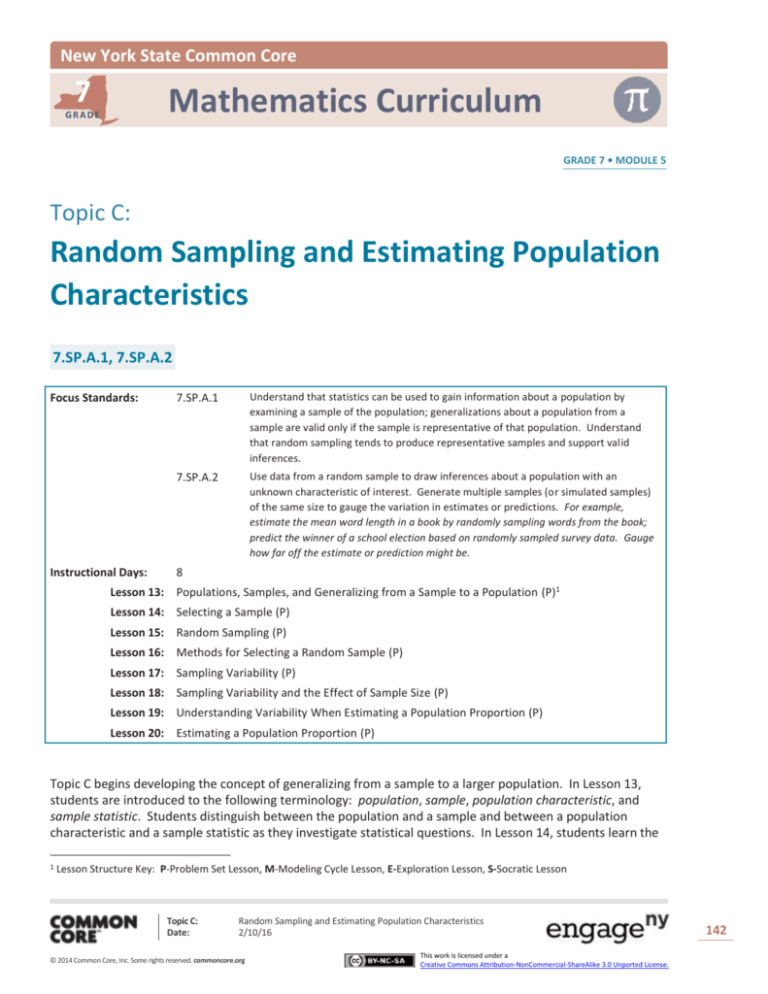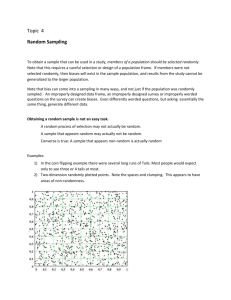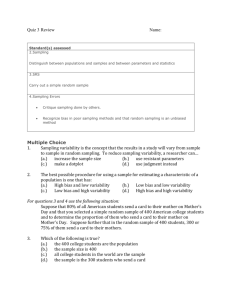
New York State Common Core
7
Mathematics Curriculum
GRADE
GRADE 7 • MODULE 5
Topic C:
Random Sampling and Estimating Population
Characteristics
7.SP.A.1, 7.SP.A.2
Focus Standards:
Instructional Days:
7.SP.A.1
Understand that statistics can be used to gain information about a population by
examining a sample of the population; generalizations about a population from a
sample are valid only if the sample is representative of that population. Understand
that random sampling tends to produce representative samples and support valid
inferences.
7.SP.A.2
Use data from a random sample to draw inferences about a population with an
unknown characteristic of interest. Generate multiple samples (or simulated samples)
of the same size to gauge the variation in estimates or predictions. For example,
estimate the mean word length in a book by randomly sampling words from the book;
predict the winner of a school election based on randomly sampled survey data. Gauge
how far off the estimate or prediction might be.
8
Lesson 13: Populations, Samples, and Generalizing from a Sample to a Population (P)1
Lesson 14: Selecting a Sample (P)
Lesson 15: Random Sampling (P)
Lesson 16: Methods for Selecting a Random Sample (P)
Lesson 17: Sampling Variability (P)
Lesson 18: Sampling Variability and the Effect of Sample Size (P)
Lesson 19: Understanding Variability When Estimating a Population Proportion (P)
Lesson 20: Estimating a Population Proportion (P)
Topic C begins developing the concept of generalizing from a sample to a larger population. In Lesson 13,
students are introduced to the following terminology: population, sample, population characteristic, and
sample statistic. Students distinguish between the population and a sample and between a population
characteristic and a sample statistic as they investigate statistical questions. In Lesson 14, students learn the
1
Lesson Structure Key: P-Problem Set Lesson, M-Modeling Cycle Lesson, E-Exploration Lesson, S-Socratic Lesson
Topic C:
Date:
Random Sampling and Estimating Population Characteristics
2/10/16
© 2014 Common Core, Inc. Some rights reserved. commoncore.org
This work is licensed under a
Creative Commons Attribution-NonCommercial-ShareAlike 3.0 Unported License.
142
Topic C
NYS COMMON CORE MATHEMATICS CURRICULUM
7•5
importance of random sampling and of using a random mechanism in the sample selection process. In Lesson
15, students select a random sample from a population and begin to develop an understanding of sampling
variability. In Lesson 16, students develop a plan for selecting a random sample from a specified population.
Students see a more formal introduction to “sampling variability” in Lesson 17, where several samples are
randomly selected from the sample population. They compute sample means and use collected data to
develop a sense of variation in the values of a sample mean and an understanding of how this variability is
related to the size of a sample. In Lesson 18, students use data from a sample to estimate a population mean.
In Lesson 19, they develop an understanding of the term sampling variability in the context of estimating a
population mean. In Lesson 20, they estimate a population proportion using categorical data from a random
sample.
Topic C:
Date:
Random Sampling and Estimating Population Characteristics
2/10/16
© 2014 Common Core, Inc. Some rights reserved. commoncore.org
This work is licensed under a
Creative Commons Attribution-NonCommercial-ShareAlike 3.0 Unported License.
143










